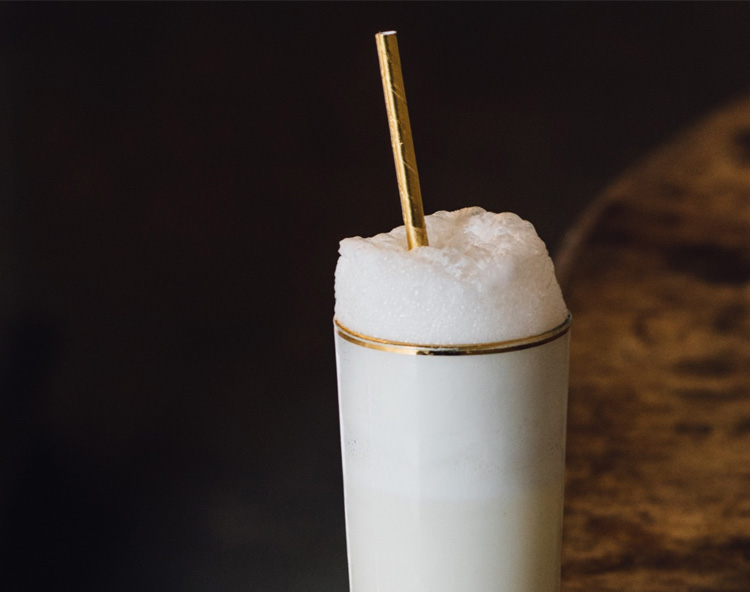The Importance of Mouthfeel
Welcome to the seventh and final piece in this series on taste, flavour, and their importance to cocktail creation. So far, we’ve primarily focused on the understanding of our taste elements (sweet, sour, and bitter in particular) and how they interact with each other, but for this article, our attention will be on all thing textural, looking at the importance of the mouthfeel of our cocktails and how paying close attention to it can add the ultimate finishing touch.
03 March 2023 · 8 min read


Speak to any chef and they’ll wax lyrical about the role that texture plays in a dish. Different textures, be that smooth or crunchy, chewy or tender, heighten our enjoyment of food by making what we eat more interesting and exciting on the palate. As such, a good chef will give the upmost consideration to the mouthfeel of all elements on the plate to ensure they are both varied and complementary. As bartenders, we don’t have the same luxury of being able to combine multiple different textures in our culinary creations (liquids, by their very nature, are of a uniform consistency) but mouthfeel is still of crucial importance, possibly in more ways that you may think.
What do we mean by Mouthfeel?

Mouthfeel is the umbrella term for the sensations we experience when eating or drinking that isn’t a taste or a flavour. When it comes to drinks, we can often think that this just refers to the consistency of the liquid – how thin or thick, velvety or viscous it is – and while that is, of course, a huge part of mouthfeel, it is one of many different sensory responses occurring when we consume a cocktail. These responses are collectively known as trigeminal sensations.
Trigeminal Sensations

Trigeminal sensations are feelings triggered by our trigeminal nerve and are responsible for all touch, pain, temperature, tingling or numbing sensations we experience as a result of eating or drinking. While you may not have heard the term before, you will be immediately aware of what they are as you experience them every single time you consume anything. Hot or cold? Trigeminal sensations. Fizzy or flat? Trigeminal sensations. Strong and intense or weak and watery? Trigeminal sensations. Spicy scotch bonnet? Cooling spearmint? Mouth-burning shot of overproof rum? Trigeminal, trigeminal, trigeminal.
Flavour, Taste, Mouthfeel... In that order?
What’s your favourite cocktail? You may have a go to drink that you’ll order every time but if you’re anything like me, it will very much depend on what mood you are in. There are three core sensory elements to every single cocktail: flavour, taste, and mouthfeel. Sometimes you may be in the mood for something strawberry flavoured. More often you may fancy something sweet, or sour for that matter. But I would hypothesise that more often than not our mood dictates the style of cocktail we desire, and that, my friends, is all down to mouthfeel. If I walk into a bar in the mood for an Old Fashioned (this is pretty much my default setting), I may be swayed towards a different spirit as the base than my usual Bourbon, or even talked into an alluring Manhattan twist or something of along those lines, but it will take a very persuasive bartender to convince me to have a Mojito, as it’s the strong, rich, intensity of an Old Fashioned that I want. Similarly, if I fancy a refreshingly light and fizzy Gin & Tonic, it’s an easier jump for me to a Whisky Highball than it is to White Lady. Even though the flavours of the latter are more closely aligned to the original G&T I desired, it’s the length and effervescence I’m looking for.
The most Important Sensation?
If we’re keeping with this idea that cocktails consist of flavour, taste, and mouthfeel, I would say there’s a compelling argument that the feeling is the most important factor for us to focus on, as it is so multifaceted. In any one cocktail there may be two or three different flavours being mixed together, and two or three different taste elements to be balanced in harmony, but when it comes to mouthfeel there can be any number of different elements working in isolation, meaning that if even one of them is out of sync, the whole cocktail falls down.
The Piña Colada

Let’s take the Piña Colada as an example and break this idea down further. Nearly every bartender has their own Piña Colada recipe. Almost all of them will tell you it’s the best you’ll ever have, but for argument’s sake, let’s say that ours is going to be the recipe employed by the team at Satan’s Whiskers in Bethnal Green, London, because, in my opinion, those guys make the best classic cocktails in the world.

Flavour
We’ve got pineapple, coconut, cream, and rum. These are flavours that are made for each other so we can be pretty sure they will work here. Of course, if our cream has turned, or the pineapple chunks are old, that will affect the final profile, but if all ingredients are fresh the flavours will match perfectly.
Taste
Piña Coladas are inherently sweet drinks; that’s how they are. Our big worry is that it will be too sweet, but as long as the pineapples have enough acidity, we should be ok.
Mouthfeel: This is where it gets interesting, let's take each one in isolation.
- Temperature – this drink needs to be ice cold. If it warms up too much it will become overly sweet and lose its refreshing quality
- Dilution – if we blend with too much ice it will be watery and weak, too little ice and it becomes overpoweringly intense.
- Texture – we want our texture to be smooth. If we don’t blend for long enough, we will have some un-blitzed pineapple pulp left that will give a bitty, unpleasant texture
- Viscosity – the perfect Piña Colada shout be thick and creamy, but not too thick that we can’t suck it through the straw – it’s a fine line between success and failure here.
As we can see, the majority of potential pitfalls in constructing a perfect Piña Colada point in the direction of its mouthfeel. While this is not necessarily the case with all cocktails, it’s interesting to look at each in isolation and see how many different trigeminal sensations the drink is ticking to ensure we are giving each the utmost attention.
Good Technique = Good Texture
The mouthfeel of our drinks comes from not only the ingredients we are using, but also the techniques we employ to mix them together. Generally speaking, the better your technique, the better the mouthfeel you can achieve. Understanding the ideal time and intensity to shake a Daiquiri for to ensure you have the maximum aeration, or the optimum temperature you are looking to achieve when stirring your Gibson, will go a long way to making your drinks feel better, but every drink is unique, and so is every bartender making them. I would always encourage that you not only test out which technique is right for each cocktail, but also to test out your own technique against other bartenders to see where you can tweak it to get better results.
Time - The mortal enemy of Mouthfeel
That being said, even if you can make a perfectly balanced Mai Tai, shake the most velvety of Espresso Martinis, or stir down the coldest of Martini cocktails, there is one crucial factor working against mouthfeel – time. Cocktails in general, and their mouthfeel in particular, are at their very best the moment they are poured, meaning the longer your drinks take to get to their intended recipient, the worse their mouthfeel will become. The Martini cocktail will warm up, the Espresso Martini will lose its head, and the longer the Mai Tai sits on ice in the glass, the more diluted it will become, so ensuring your drinks get in the hands of your guests double quick should be a priority of every bar and bartender.
Roundbuilding

Quick, efficient, and technically proficient bartending is a subject that deserves far more attention than I could hope to give it in a space of one of these articles. Thankfully, I don’t have to, because the Dan Waddy and Kevin Armstrong from Satan’s Whiskers, undoubtedly two of the finest bartenders of my generation, have literally written the book on it. Roundbuilding, in my opinion, is one of the most important books ever written on the craft of professional bartending, and the lessons it holds will ensure each and every one of you cocktails reach where they need to be as quickly as possible. Looking, tasting, and most importantly feeling as good as they can. ———— The views and opinions expressed in this article are those of the author and do not necessarily reflect those of Freepour.









